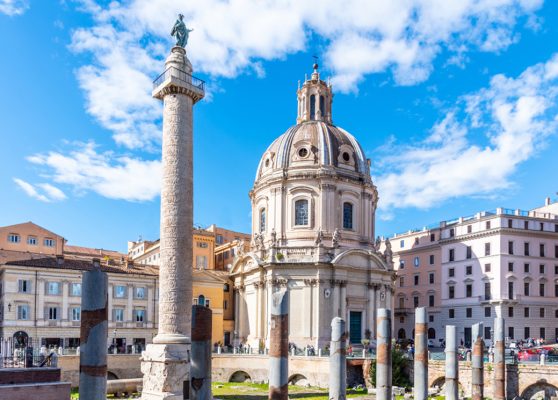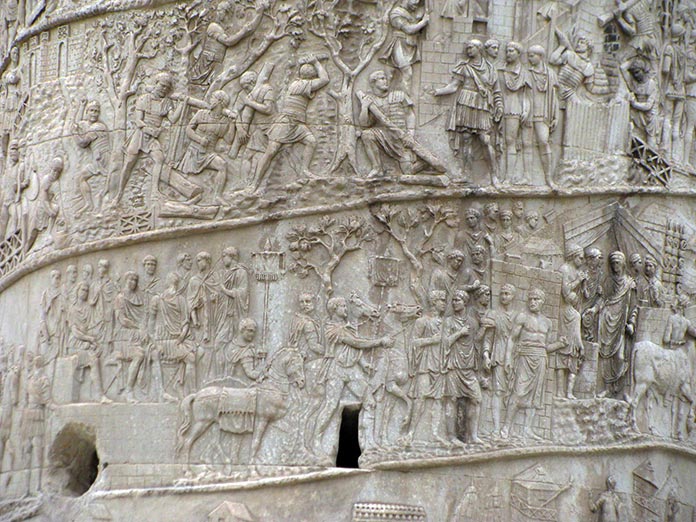Trajan’s Column
Trajan’s Column is a triumphal monument commemorating Emperor Trajan’s victory in the wars against the Dacians. It is famous for the spiral bas-relief that surrounds it.
Built in: 113 AD
Architect: Apollodorus of Damascus
Location: Via dei Fori Imperiali

The Column of Trajan, built by the architect Apollodorus of Damascus, was inaugurated in 113 AD in the Forum of Trajan, located behind the Basilica Ulpia between the Bibliotheca Ulpia and the Traiani. It was erected in honour of Emperor Trajan to commemorate his victories in Dacia (present-day Romania).
In the art of Imperial Rome, the Column was a shocking novelty, emerging as the outstanding element of sculptural relief of the time. A completely independent artistic formulation emerged as the first form of Roman art even though it was the natural extension of Greek and Etruscan art.
The fascination of Trajan’s Column, the first Coclid column, is the Frieze with all the figures recounting the Emperor’s two military campaigns. A band of beautifully sculpted reliefs winds around the column for more than 180 metres in length with about two thousand figures.
Trajan is present in about sixty scenes narrating the war events against the Dacians conducted between 101-102 and 105-106 AD. From the base, the width of the band varies from 0.89 m to 1.25 m upwards so that when viewed from the ground in perspective the carved figures are equal in proportion.
18 gigantic blocks of Parian marble, each weighing about 40 tonnes with a diameter of 3.83 metres, make up this excellent sculptural masterpiece. The top of the column is reached via a spiral staircase of 185 steps.
The top of the column is reached via a spiral staircase of 185 steps. The interior catches the light from 43 open slits on the historiated frieze spiralling along the shaft 23 times, with 150 scenes. Trajan’s column represents one of the absolute masterpieces of sculptural art of all times. The same Bernini affermò che la Colonna Traiana “was the source from which all great men had drawn the strength and greatness of their design”.

The story begins with soldiers preparing for war and ends with the defeat of the Dacians. The long frieze unfolds from bottom to top and from left to right with the transit over a pontoon bridge over the Danube of Roman soldiers initiating the first campaign in Dacia (101-102 A.D.). The deployment and order with which the different contingents prepare for war can be grasped from the minuteness of the details and the definition of the figures.
The theatres of battle are punctuated by constructions of bridges, roads, bivouacs and paintings in which Trajan himself emerges in preponderant proportions in relation to the militia.
The chronology of the narrative is methodical and of fine compositional quality, both in its uninterrupted rhythmic scansion and in the preciousness of the reliefs, which were originally, as in all Roman works, painted in vivid colours of which, unfortunately, little evidence remains. The column consists of twenty-nine pieces of white marble, the largest weighing up to seventy-seven tonnes.
Repeatedly portrayed, the Emperor Trajan displays a classical demeanour and marked authority, echoing the typical representation of historical relief. A communicative attitude of Roman imperial power combined with the dominant power of arms.
Trajan’s column, including its base, is forty-two metres high, exactly the same height as that of the hill on this site. A pagan monument like Trajan’s column escaped the destructive work of the Christians because there was a belief that the emperor’s soul was saved by the prayers of St. Gregory.
Initially, a statue of an eagle stood at the top of the column, but after Trajan’s death it was replaced by the six-metre-high gilded bronze statue of the Emperor himself.
His ashes and those of his wife Plotina were placed in the burial chamber at the base of the column. In 1587 the statue of the Emperor was replaced again by Pope Sixtus V with the statue of St Peter that still stands at the top of the column.
Trajan’s Column: your opinions and comments
Have you visited this monument? What does it mean to you? What advice would you give to a tourist?
Tours